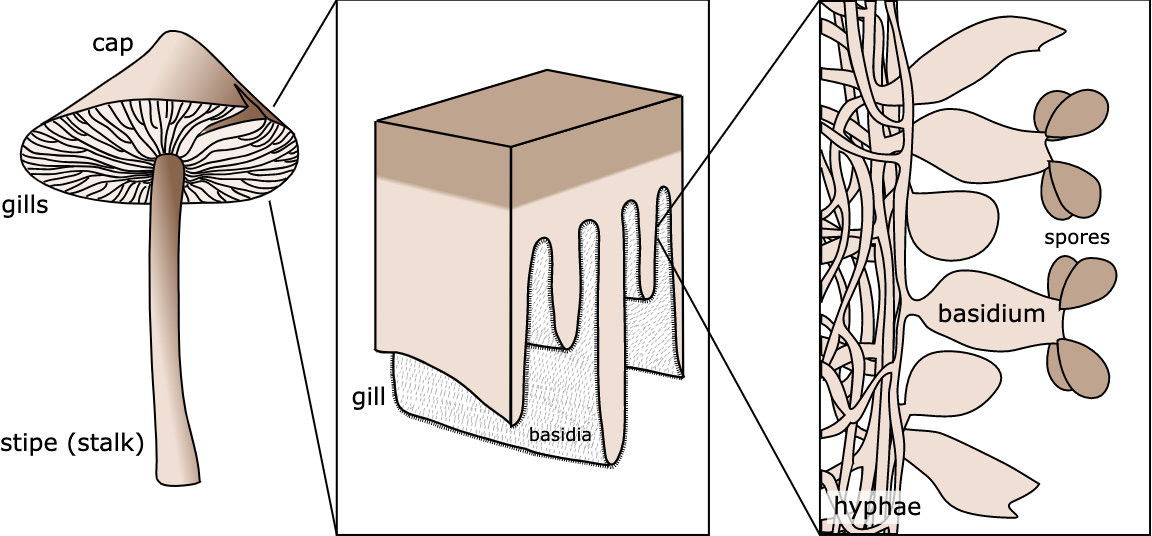Fungal Life Cycles: From Spore to Fruit
Introduction
The fungi kingdom is split into several phyla. The species within each phylum can be characterized by their distinct reproductive processes and life cycles. In this article, we will give an overview of the reproduction cycles of the phyla known as Basidiomycota, Ascomycota, and Glomeromycota.
Basidiomycota
A phylum of the fungi kingdom, Basidiomycota includes mushrooms like puffballs and chanterelles. They are characterized by their specific spore, also referred to as basidiospores.
Ernst Haeckel - Kunstformen der Natur (1904), plate 63: Basimycetes (see here, here, here and here)
The spores are formed on specialized basidia cells.
By Debivort - From English Wikipedia, CC BY-SA 3.0, https://commons.wikimedia.org/w/index.php?curid=1342170
They grow in the mycelium filaments that reach into the ground, and sexual reproduction occurs when the haploid spore (haploid: contains half the number of chromosomes that are in a fully-formed organism) meets up with another mycelium and link together in a process called plasmogamy. Asexual reproduction can also occur through budding, where spores become encased in a protective layer and break off from the parent organism. The spores are dispersed by the air, water, and insects, and make their way into the ground where they begin to grow mycelium and find another mycelium to link with. After a mycelium becomes diploid (containing the full number of chromosomes) the mushroom begins to grow above the ground, finally forming the fruiting body and completing the life cycle.
This image has been created during "DensityDesign Integrated Course Final Synthesis Studio" at Polytechnic University of Milan, organized by DensityDesign Research Lab in 2015. Image is released under CC-BY-SA licence. Attribution goes to "Anita Righetto, DensityDesign Research Lab". - Own work
Ascomycota
Ascomycota is another phylum of fungi that, together with Basidiomycota, form the subkingdom Dikarya.
Ernst Haeckel, Public domain, via Wikimedia Commons
These fungi include yeast used in baking and brewing, and also gourmet truffles and morels. This division gets its name from the ascus, which is the sac-like structure that contains the haploid spores of the organism, known as ascospores.
They mainly reproduce asexually by releasing spores that germinate, form mycelium, which then meets up with another mycelium to form a diploid, similar to Basidiomycota. In sexual reproduction, there are “male” and “female” strains; the male strain produces an ascogonium, and the female strain produces an antheridium. The ascogonium and antheridium fuse at fertilization through plasmogamy and start a new mycelium. Check out this illustrated diagram for more detail on how Ascomycota reproduce.
Asci and ascospores, Morchella elata (morel), 40x objective, phase contrast, Zeiss Axio Imager.A1 microscope, Zeiss AxioCam MRc CCD image, Merritt College, Oakland, CA
Image By Peter G. Werner - Own work, CC BY 3.0, https://commons.wikimedia.org/w/index.php?curid=4204509
Glomeromycota
Another of the 5 fungi phylum, Glomeromycota is a newly established division which includes fungi that are essential to land plants, especially their roots. The species in this phylum are mycorrhizal, meaning they form symbiotic, mutually beneficial relationships with plants. The fungal cells and plant root cells interact in the soil, with the plant supplying carbon and carbohydrates to the fungus for growth and energy, and the fungus supplying water and essential mineral nutrients from the soil to the plant.
The species of Glomeromycota do not reproduce sexually; all their reproduction is asexual and involves the roots of the plants they rely on. These organisms form spores called glomerospores, which have very thick cell walls for protection. Once the spore is dispersed into suitable conditions, it begins to grow a short mycelium that searches for a root host. Once contact has been made with a host, the organism grows. If no root host is found, the mycelium will retreat back into the spore and wait for better conditions.
Lotus corniculatus var. japonicus kolonisiert durch Gigaspora margarita
Image By Mike Guether - Own work, CC BY 3.0, https://commons.wikimedia.org/w/index.php?curid=2775800
Sources:
“Basidiomycota: The Club Fungi.” Lumen Learning.
https://courses.lumenlearning.com/wm-biology2/chapter/basidiomycota/
“Ascomycota: The Sac Fungi.” Lumen Learning.
https://courses.lumenlearning.com/wm-biology2/chapter/ascomycota/
“Glomeromycota.” Microbiology (Boundless).
“Characteristics of Division Glomeromycota.” Roehl, 2017. Fungus Fact Friday.







